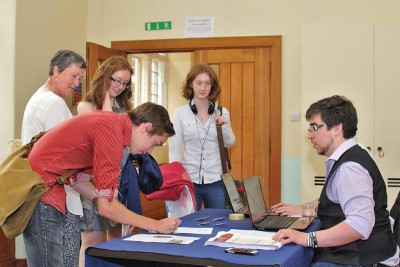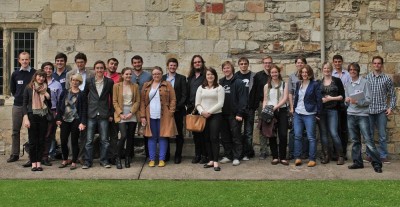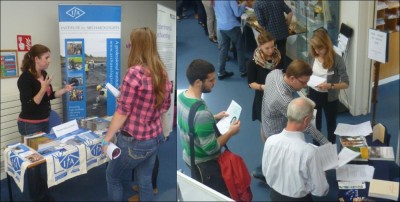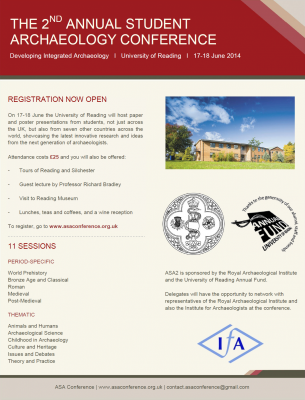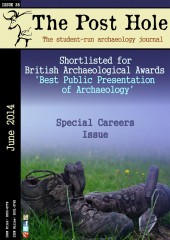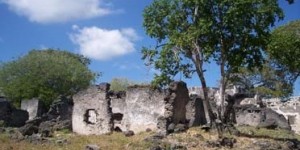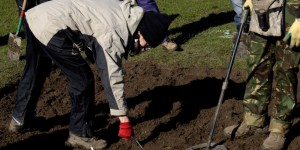The 29th May is an unusual day, beginning with Assessed Lectures from 09:30 for my fellow University of York Bioarchaeology and Zooarchaeology Masters students and I. One of the most positive points about York’s Masters programmes is that students are assessed in a wide range of ways. Between September and March, our learnt knowledge had been tested with essays and practical exams, and less formally with weekly seminar presentations. With such a well-rounded development of skills in expression of knowledge and original thought, giving a thirty minute lecture on a Masters dissertation proposal was far from daunting.
However, from giving my own lecture and listening to eleven other eclectic, yet equally fascinating presentations of student research and ideas, it was only too obvious to me that the discipline of archaeology is greatly missing out on these fresh visions. The following day, the 2014 EUROPA conference was held in dedication to the long and hugely influential work of Professor Alasdair Whittle. Many students will recognise his name from his seminal 2011 publication, Gathering Time; however, his contributions to the discipline span almost forty years. Looking around the room at the other conference delegates, I am disappointed to see how few young people there are, not because I don’t appreciate the presence of older generations (quite the opposite), but because such an observation is ominous that the institution of archaeology is failing to connect with younger generations of researchers.
Perhaps it’s just me, but the evolution of archaeological theory seems to have slowed down in the last couple of decades. Half a century ago there were new paradigms of theory and novel research questions emerging every decade, from the accession of processualism and the study of systems, to the arrival of post-processualism and an arguable resurged interest in subjective interpretation of human agency, and the development of new approaches to the past such as phenomenology (Johnson 2010).
These paradigm shifts always attract furore and inordinately expose a minority of academics’ egos (perhaps because in academia, criticism of one’s views is felt by some as disparagement of their whole careers), though at the same time they drive the discipline forward. Perhaps because they don’t have personal allegiances and rivalries, or careers of the same length that can be attacked, whether you now like them or not, the greatest contributors to those paradigm shifts arguably came from students and recent graduates (including Lewis Binford, David Clarke and Colin Renfrew, and then Henrietta Moore, Michael Shanks and Christopher Tilley).
This article does not suggest the discipline requires another paradigm shift in theory; rather, it insists that established practitioners of archaeology need to change their practical and ideological approach to the discipline. Whilst a hierarchy in academic archaeology can indeed help structure the discipline to suit today’s increasing bureaucratisation of academic policy and funding, it needs to allow greater permeability in the engagement and expression of ideas from individuals in all levels and sectors of our collective enquiry into the past.
The 2014 EUROPA conference was a fascinating, relevant and well-organised event, so why did it attract so few students and early career researchers? The first barrier that should come to mind is cost. This particular conference cannot be criticised because it offered a reasonable student rate for registration (£15 for the first day, £20 for the second day or £30 for both days), though factor in the exorbitant cost of train travel and accommodation, and perhaps you may understand why sadly I could only attend the first day of this conference. It is clear that in most cases, travel and accommodation vastly exceed the cost of conference registration, though it is only politicians and the providers of those expensive yet necessary services that can intervene, so the unfair reality is that organisers of conferences will have the financial responsibility of helping widen the demographic of their audience, at least in the foreseeable future.
Another significant barrier in the attendance of conferences by students is the time of year they take place. The Theoretical Archaeological Group (TAG) conferences take place each year around mid-December, coinciding with the start of the university Christmas vacation, however, undergraduate students in many universities take exams immediately following this vacation and bow to the pressure of squeezing revision around festivities during this time. I, and many other students in this situation, did not attend their first TAG conference until they were at least Masters students when the nature or timing of assessments changed. Those students who do not have exams after Christmas may have them in May, which might partly explain the low attendance of students to EUROPA 2014.
For bioarchaeology undergraduates, a similar challenge from looming dissertation deadlines may prevent attendance to the UK Archaeological Science conference that takes place every other year during the Easter vacation (this again affected me in my undergraduate third year, and as such, I eagerly anticipate my first UKAS conference next year). The summer vacation is just as problematic as many students take on summer jobs to supplement their tuition fees, and as such are likely to miss the many smaller, more specialist conferences that take place during the summer, as well as another major forum, the British Association for Biological Anthropology and Osteoarchaeology (BABAO) annual conferences in mid-September, just before the start of the academic year for most universities.
Finally, and perhaps most addressable, the institution of archaeology needs to evaluate how it engages with each different demographic involved in the discipline. This includes not only students and younger generations more generally, but also practitioners in the non-academic sectors of the discipline, and the enthusiasts and general public ‘outside’ the discipline, though essential to its non-self-seeking existence. As I have previously argued, incidentally with a paper at my first TAG conference last December (Altoft 2013), we are all in need of a more ‘integrated archaeology’.
This article is not providing answers on how we can achieve a more ‘integrated archaeology’; instead it is highlighting the example of a lack of student participation in conferences and general exchange of knowledge that occurs without this much-needed state of the discipline. I will close this article with a case study of my work with the Annual Student Archaeology conference, as well as reflections on the first day of the 2014 EUROPA conference, in order to hopefully persuade all members of the field of archaeology, from the most uninitiated to the most esteemed, to together develop further new approaches that can achieve a more integrated understanding and appreciation of the past.
In December 2012 Navid Tomlinson, then, like me, a third year undergraduate at York, had the opportunity to attend TAG. There he met Alistair Galt, also a third year undergraduate at the University of Durham. In discussion, they agreed that there was a lack of opportunity for students to present their research orally beyond the written means that The Post Hole was already providing. At the time, I was Editor-in-Chief and Taryk Welburn, another third year undergraduate at York, was Managing Editor of The Post Hole. Navid shared with us his idea for a student conference at York in June 2013, and together the three of us made all the arrangements for it to take place. Although Navid was to leave archaeology following his degree and Taryk was to cross over to Cultural Heritage Management in his subsequent Masters at York, I envisaged that the conference could have a long and influential history ahead of it and be universally representative of students on (at least) a national level if branded as the Annual Student Archaeology (ASA) conference and organised by a committee of students at a different university each year.
After only five months of preparation (less if accounting for the dissertations and other assessments that also took up our time), the first Annual Student Archaeology conference took place on 19-20 June and attracted 80 delegates from across the UK, as far afield as Aberdeen and Southampton (Figures 1 and 2). ASA1 featured 24 papers and 6 posters on a diverse range of innovative research, from the depiction of stereotypes in popular representations of archaeology, such as the Horrible Histories books, by Rachael Sycamore (second year Durham undergraduate) to the zooarchaeological analysis of spurs used in cock-fighting in Roman Britain by Sean Doherty (third year Nottingham undergraduate).
One of the highlights of ASA1 for me was that it featured genuinely exciting research by students of all levels from first year undergraduate to PhD. As part of chairing the session on identity, I had the pleasure of introducing a fantastic paper by York first year undergraduate, Victoria Gladwin, on the identification of non-binary gender representations and intersex people in the archaeological record. Victoria’s paper alone plainly demonstrated the untapped contributions students can make to the progression of the discipline, and how every effort made for all opportunities of academic discourse should be open to not just lecturers and post-doctoral researchers, not even just doctoral students as well, but all members.
Following the first Annual Student Archaeology conference, I established a national committee that could steer the direction that the conference series would take in future years; including the selection of applicant hosts of the next ASA conference, this year the University of Reading for ASA2, and discussion at each conference AGM of ways in which ASA can enable more students to easily participate in the discipline. One of the main issues facing students is their ability to attend ASA and all other conferences because of the reasons outlined above. During the second Annual Student Archaeology conference at the University of Reading on 17-18 June, this and other matters were discussed, and questionnaires were given to delegates to widen the national committee’s understanding of the current impact of ASA on widening participation in archaeology and how that can be furthered in the future (Figure 3).
Unfortunately, this year the organising committee were unable to secure a deal with any accommodation providers in Reading to make that cost inclusive in the registration fee, though this will be focused on for future ASA conferences. However, the engagement of ASA continues to grow, as reflected by this year’s 33 accepted paper abstracts and 12 accepted poster abstracts from students not just across the UK, but also from six other countries: Brazil, India, Nigeria, Poland, South Africa and the United States.
Not only is ASA reaching to people across borders, it hopefully will encourage attendance from people across demographics. Presenting at an ASA conference is a valuable experience for students, though it is even more impactful if it is attended by an integrated audience. Both the organising committee and the national committee are establishing new forms of promotion to academics, non-academic practitioners, enthusiasts and the public. The Institute for Archaeologists and the Royal Archaeological Institute held stalls at ASA2 allowing delegates to network with these two organisations (Figures 4 and 5); and kind sponsorship from the RAI and the University of Reading Annual Fund allowed attendance to an even larger programme for ASA2 to cost only £25 (Figure 6).
It is an exciting time to be involved in ASA and I am delighted so many people attended ASA2 to have the opportunity to witness more important student research and hopefully consider either joining the national committee or applying to host ASA3. If you missed ASA2, you can still pursue these two fantastic opportunities. Details on how to join the national committee for 2014-15 or apply to host ASA3 in 2015 will be released on the ASA conference website, www.asaconference.org.uk, and announced on the ASA Facebook and Twitter pages on 1 July.
Returning finally to EUROPA; I wish to congratulate Alasdair on his long and hugely important career in archaeology. I am sure there is much important work still ahead for Alasdair. Being a conference in dedication to Alasdair, it was perhaps not too surprising that the overriding theme of the first day of EUROPA 2014 was “just what exactly is the Neolithic?”. In his paper, ‘The earlier Neolithic body in southern England and its continental background’, Dr Oliver Harris (University of Leicester) asked whether it is necessary for terming of ‘the Neolithic’, that there is a full package of farming, pottery and polished stone tools, as he quoted John Robb (2013) as suggesting: “‘The Neolithic’ is a heterogeneous set of human-material relationships which people participated in variably”. Such an understanding of the Neolithic seems confused and will continue to be, as Harris (2014) highlights, if we continue questioning whether or not a particularist approach to culture change in this period is suitable or not in our awareness that real-world existence is multi-scalar in space and time, and is assessed archaeologically through isolated characteristics (bodily, materially, environmentally and economically).
Despite being period-specific, this is an example of where a more integrated participation in archaeology would likely offer fresh perspectives on old questions that have been recurring over the last couple of decades. In her paper, ‘Evidence for the Mesolithic-Neolithic transition in northern England and Wales’, it was cringe-worthy, though nonetheless true of Dr Seren Griffiths (Manchester Metropolitan University) to analogise our necessary understanding of the ‘Neolithic transition’ with Robin Thicke’s song, ‘Blurred Lines’ (Griffiths 2014). I responded in a similar manner (without the analogy) to a question following my Assessed Lecture the previous morning. My proposed Masters dissertation research is to contextualise an element of Neolithicisation of western Russia with organic residue analysis of early pottery from the Pontic Steppe and boreal forest zone. The owners of the pottery in the Pontic Steppe were farmers, though the owners of the pottery in the boreal forest further north maintained a hunter-gathering subsistence. In my lecture I referred to the former as Neolithic and the latter as Mesolithic, despite both possessing pottery. A little bit of organisation, whether it be the use of the term ‘Neolithic’, or the academic hierarchy of archaeology, is helpful, though we need to be more prepared for some ‘Blurred Lines’ if our understanding, and our younger researchers, of archaeology are to develop over future ‘gathering time’.
Bibliography
- Altoft, D.T. (2013) ‘Student development of integrated archaeology: The Post Hole as a case study’. Paper presented at the 35th Annual Conference of the Theoretical Archaeology Group, Bournemouth University. 16 December 2013.
- Griffiths, S. (2014) ‘Evidence for the Mesolithic-Neolithic transition in northern England and Wales’. Paper presented at the 2014 EUROPA conference, Cardiff University. 30 June 2014.
- Harris, O.T.J. (2014) ‘The earlier Neolithic body in southern England and its continental background’. Paper presented at the 2014 EUROPA conference, Cardiff University. 30 June 2014.
- Johnson, M. (2010) Archaeological Theory: An Introduction. Chichester: Wiley-Blackwell
- Robb, J. (2013) ‘Material culture, landscapes of action, and emergent causation’. Current Anthropology, 54 (6), pp. 657-683


